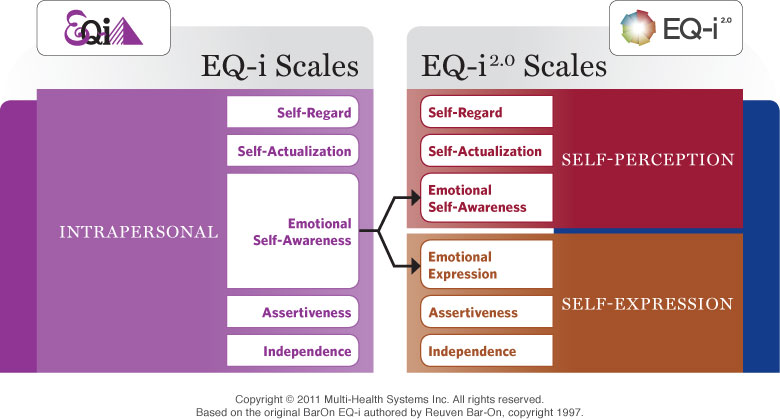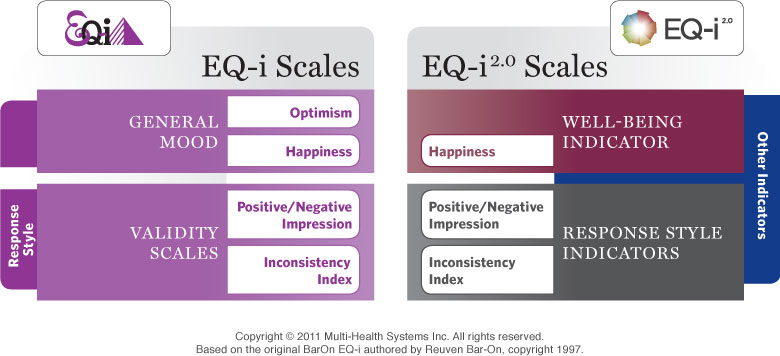Part I: Getting Started with the EQ-i 2.0
The EQ-i 2.0 Framework
Overview
Since the seminal work of Bar-On (1997, 2004), interest in emotional intelligence has continued to blossom. In response to the vast research that has emerged over the years, the operational definition of emotional intelligence has evolved, affecting the conceptual model of emotional intelligence and driving the need to reconsider empirically the factor structure of the EQ-i® (Bar-On, 1997). The final form of the EQ-i® 2.0 consists of 133 items, representing 15 subscales (with 7 to 9 items per subscale), a Well-Being Indicator and 3 Validity Indicators, teamed with a corresponding 360 degree assessment that is designed to complement the EQ-i 2.0.
Although based on the original factor structure of the EQ-i (Bar-On, 1997), the EQ-i 2.0 and EQ 360® 2.0 are the products of several model changes that are deemed practically, empirically, and theoretically sound. A side-by-side comparison of the EQ-i factor structure to that of the EQ-i 2.0 can be seen in Figure 3.1. The process used to arrive at the conceptual changes has involved many steps, including item analyses, item development, data collection and analysis, and expert reviews. A detailed description of the Stages of Development can be found in EQ-i 2.0 Stages of Development and statistical support for the model changes can be found in Standardization, Reliability, and Validity.
It is the goal of this and the next section to highlight the major changes to the model of emotional intelligence, including changes to the operational definition of emotional intelligence and the realignment of the Intrapersonal, Adaptability, Stress Management, and General Mood Composite scales, while addressing modifications to their underlying subscales.
The realignment of the composite scales and subscales yields a model of emotional intelligence that is even more intuitive than its predecessor. The total EI score is considered a snapshot of one’s overall emotional intelligence and potential for effective emotional and social functioning. The EI composite and subscales provide an opportunity to look deeper into the underlying facets of emotional intelligence that drive behavior. The following structural and alignment changes of the EQ-i have resulted in a model better equipped to serve this purpose.
Figure 3.1. A comparison of the EQ-i and the EQ-i 2.0

Intrapersonal Composite
The Intrapersonal Composite scale of the EQ-i was initially comprised of two related but functionally unique content areas: self-awareness and self-expression. The rich information provided by the combination of the Self-Regard, Self-Actualization, and Emotional Self-Awareness subscales spawned insight into how a given individual perceived him or herself. While the combination of Assertiveness and Independence reflected how one presented one’s internal self to the external world, these areas did not directly assess the overt expression of emotions. Previously, the Emotional Self-Awareness subscale captured how one not only perceived, but also expressed, oneself.
Upon reflection, consultation, and further data analysis, a logical divide became evident: split the Intrapersonal Composite scale to more specifically and deliberately address how one perceives oneself, and complement that composite scale with a new composite scale capturing how this internal perception is expressed. As a result, the Intrapersonal Composite scale was divided and the Self-Perception and Self-Expression Composite scales were born.
To fully account for this division, the content of the Emotional Self-Awareness subscale now needed to conform to the new factor structure. The items pertaining to self-awareness were retained and now reside in the Emotional Self-Awareness subscale of the Self-Perception Composite. The self-expression items were also retained and expanded to better address how one expresses oneself, inspiring the addition of the Emotional Expression subscale. The end result captures the essence of emotional perception and emotional expression by way of two unique but related composite scales, each containing three subscales (Figure 3.2).
Figure 3.2. The realignment of the Intrapersonal Composite Scale

Interpersonal Composite
The Interpersonal Composite scale of the EQ-i was designed to address one’s ability to develop and maintain mutually satisfying relationships; remain comfortable and competent while meeting and relating to others; and be a contributing and effective member of one’s social group. The inclusion of the Interpersonal Relationships, Empathy, and Social Responsibility Subscales proved to be a powerful component of emotional intelligence. Although minor changes to the items were made, this composite scale was left intact.
Adaptability and Stress Management Composite
Two defining aspects of emotional intelligence include how well we cope with our daily demands and pressures, and how effectively we use emotional information to optimize our decision making process.
The Impulse Control and Stress Tolerance subscales combined to provide insight into how well one could tolerate stress without experiencing significant setbacks, falling apart, or even losing control. Although beneficial, the Stress Management Composite did not include the mechanisms that could help an individual buffer stress or otherwise cope with arguably the greatest source of stress: change. Upon reflection and data analysis it seemed that in order to better address the needs of a Stress Management Scale, a natural psychological buffer was necessary, as was the need to address one’s capacity to cope with change. As a result, the Stress Management Composite was restructured to include Optimism (a natural factor for enhancing one’s ability to tolerate, and remain resilient in the face of, stress), Flexibility (ability to adapt to change), and Stress Tolerance (ability to cope with and manage stress).
It was also recognized that well established emotional intelligence includes the ability to use emotional information to optimize decision making, and that the Adaptability Composite could be restructured to cover this key element and provide enhanced utility to the end user. The Decision Making Composite was established and consists of the three subscales of Problem Solving, Reality Testing, and Impulse Control. Together the three subscales capture the process one is likely to use when making decisions. The application of emotional information (Problem Solving), while remaining objective (Reality Testing), paired with the ability to delay immediate gratification (Impulse Control) when necessary, provides the foundation for making effective decisions.
The realignment and restructuring of the Adaptability and Stress Management Composite scales (Figure 3.3) has resulted in the formation of the Decision Making Composite, which is intuitive, easy to coach, conceptually sound, and addresses a key element of functioning. As well, there is a more structurally sound and practical Stress Management Composite. The notion of Adaptability is still deemed important but, defined broadly, the construct of adaptability runs across the many facets of emotional intelligence.
Figure 3.3. Realignment and restructuring of the Adaptability and Stress Management Composite Scales

General Mood
The General Mood Composite has long been considered a barometer of one’s overall emotional intelligence. After all, emotional intelligence is an indicator of social and emotional effectiveness and well-being. However, the General Mood Composite - made up of Optimism and Happiness – can be considered a product of one’s emotional intelligence. Although optimism and its associated behaviors can be taught, acquired, and developed, happiness on the other hand is a direct by-product of many other behaviors, beliefs, and attitudes. As a result, it was determined that Optimism served a greater function in the Stress Management Composite, leaving Happiness as an isolated factor. Given the unique information that the Happiness subscale brings to the EQ-i, it needed to be retained.
In recent years an abundance of research into happiness has appeared in academic and mainstream chronicles, with a common message: “Happiness is essential to well-being and quality of life, but you don’t just become happy.” Happiness is an attitude and a by-product of other psychological skills that one has at his or her disposal (Davidson & Lutz, 2008; Flora, 2009; Seligman, 2002). Happiness can be considered a consequence of emotional intelligence and, as a result, has been retained as a well-being indicator: a measure of one’s feelings of satisfaction and contentment.
Figure 3.4. Realignment and restructuring of the General Mood Composite Scale
